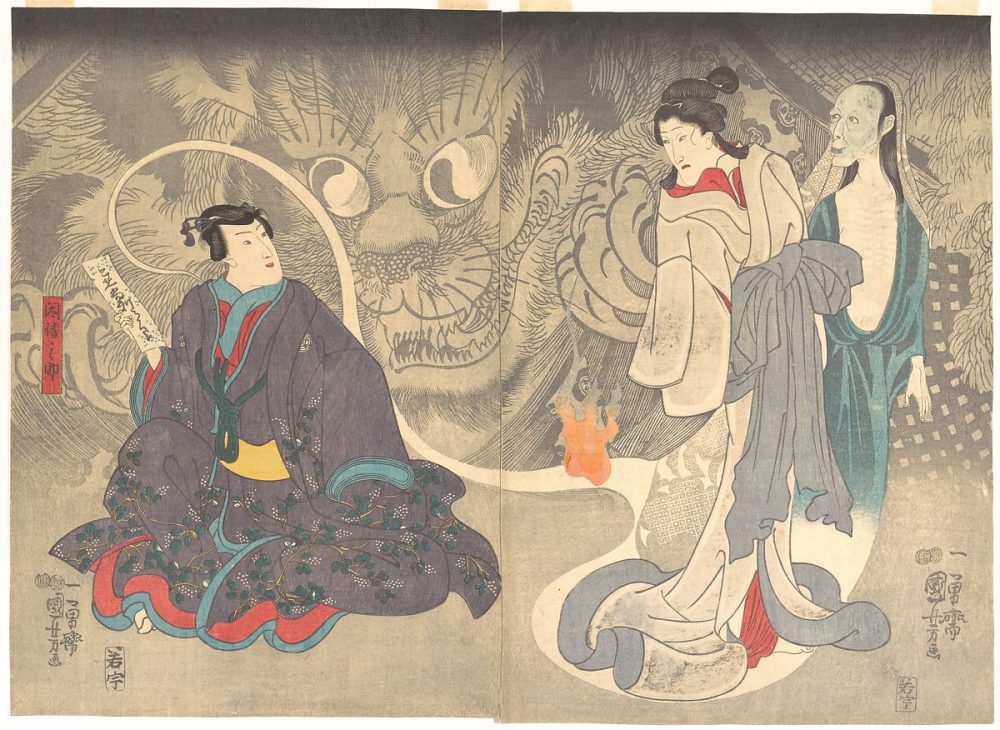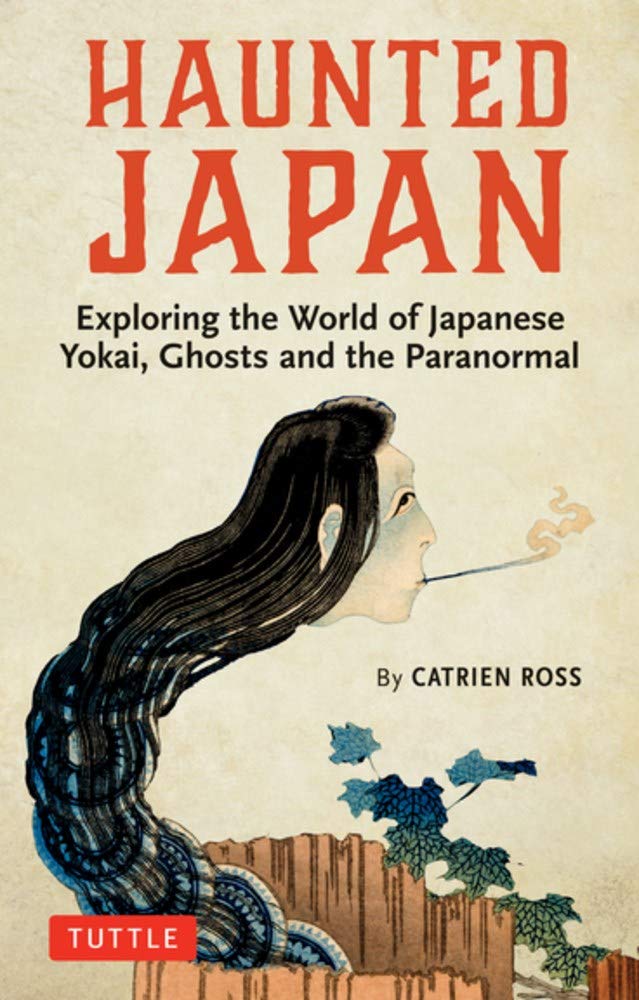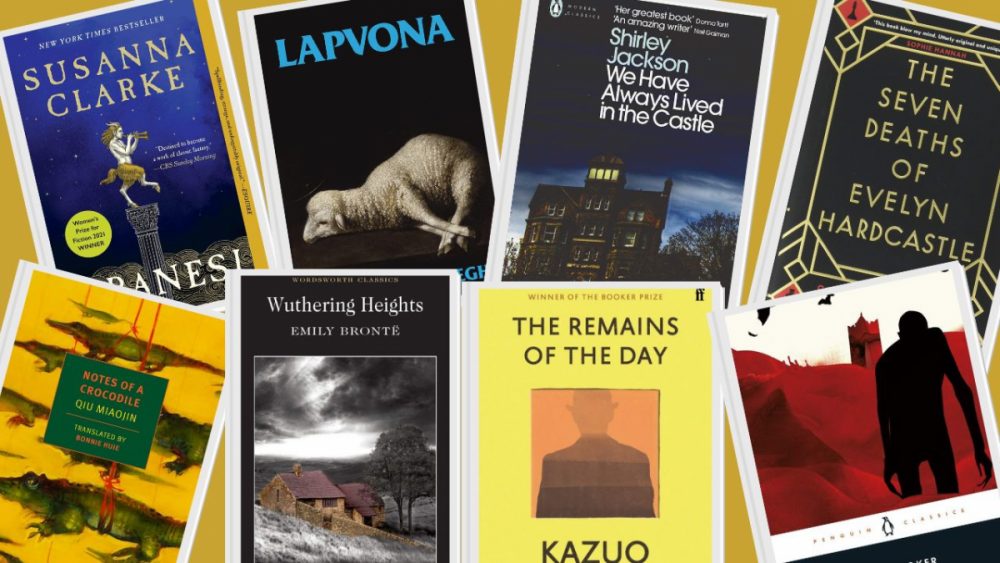The ghosts and demons (yokai) of Japanese folklore represent some of the most imaginative, diverse, and strange supernatural creatures anywhere in the world. Vengeful spirits and man-eating demons; haunted furniture and the ghosts of abandoned children populate the best Japanese ghost stories.

Japanese ghost stories are a deep well of fantastical, terrifying wonders. They have inspired writers, animators, and filmmakers across Japan and beyond, from Junji Ito to Hayao Miyazaki. Here are ten such captivating Japanese ghost stories, all of which originally appeared in Haunted Japan by Catrien Ross.
If any of these ten tales, rewritten here, captivate you and leave you wanting more Japanese ghost stories, more supernatural tales, more spiritual history and context, consider picking up a copy of Ross’ brilliant book.

Parlour Children
Before we begin this, one of the most famous Japanese ghost stories, a note on the Japanese ghosts known as zashiki warashi (parlour children): In Japan’s Tohoku region, poor families would often abandon children they could not afford to raise, leaving them to die.
Those abandoned, dead children would eventually come to haunt homes in the region as zashiki warashi. Now, on with the story.
Many, many centuries ago, in an unassuming Iwate village, there lived a kind, lovable man named Masaimon. Masaimon was beloved by the other villages for his friendly, sweet nature. He lived well, and his family had a home and enough money to live.
But one day, a travelling monk approached Masaimon and warned him that he would soon fall into complete ruin, with no money left for his family. Masaimon was left feeling shaken, confused, and frightened. The monk’s words wouldn’t leave him and, soon, his dread and anxiety turned to fever and sickness. Bedridden, Masaimon was visited by the sound of light and quick footsteps from above. Perhaps those of a child.
When they at last fell silent, the footsteps were replaced by a voice. It also came from above and asked Masaimon: “Are you dead? Are you dead?” Droplets of water fell on Masaimon’s head and the voice warned him: “Limbo is very cold”.
When the ghost child showed itself, it was soaking wet from top to bottom, dripping water onto the floor. Masaimon passed out from the shock. When he woke, the shoji screens on every side were quaking, followed by echoes of childish laughter and the question repeating itself: “Are you dead? Are you dead? Are you dead?”
The fear consumed the sick and weak Masaimon, and he fell dead from the shock, leaving the house silent and unwanted. When nobody would even visit the home, much less buy it, his family fell into ruin, just as the monk had warned. This is one of the most popular and renowned Japanese ghost stories ever told.
Old Mountain Woman
Many of the yokai to populate Japanese ghost stories are those of women, and one popular rural yokai takes the shape of a man-eating ogre (oni) woman who is said to reside in the wild mountains.
This is one of many Japanese ghost stories about one such mountain-dwelling ogre woman.
At the base of a large mountain lived a family with three sons. One day, the mother tells her sons that she must go away for a short while, and that they must keep the door closed, no matter who comes knocking. It was known to everyone in the area that a man-eating ogre woman lived in the dense forest near the mountain’s peak. If she knows that the boys are home alone, she will come knocking.
Once the mother has given her warning, she leaves. That night, there comes a knock at the door. When the oldest son reaches the door, he asks: “Who’s there?” The ragged voice of a woman says: “I am your neighbour and I desperately need help.” The oldest son refuses to open the door, believing it to be the ogre woman in disguise.
The next night, there comes another knock at the door. When the youngest son asks: “Who’s there?” A silky, soft woman’s voice answers: “I am a friend of your mother’s, here to deliver a message.” “Show me your hand”, says the youngest son.
Through the crack in the door, the son spies a weathered hand with long fingers, covered in coarse hair. He refuses to answer the door. On the third night, there is one more knock at the door. The middle son asks: “Who’s there?” The voice of a woman answers: “It’s your mother. I have come home.”
When the middle son asks to see her hand, he sees through the crack only a soft, delicate white hand. Satisfied, he opens the door.
There, filling the doorframe, is the ogre woman. She reaches out and snatches the middle son, devouring him quickly. The two remaining sons flee the house and gather up armfuls of stones before climbing a nearby tree, so tall it might reach the heavens.
When the ogre gives chase and makes it halfway up the tree, the boys rain down stones on her head. The ogre loses her balance and crashes to the ground, her blood seeping into the roots of the tree.
The Eyes
A classic yokai of Japanese ghost stories is the mokumokuren (or “many eyes”) whose origin may be traced back to scholar, poet, and artist Toriyama Sekien.
The mokumokuren yokai is said to haunt the shoji screens and tatami mats of Japanese homes and temples. This is one of many Japanese ghost stories about the mokumokuren yokai.
The Mokurenji (Temple of Many Eyes) had been abandoned for as long as anyone could remember. No monk tended the temple, but there were frequent whispers of a fox, or perhaps a tanuki, roaming the temple grounds. More whispers were told about the temple and why it had been abandoned.
It soon became a place of legends and local myths, with children claiming that any man brave enough to last a night alone in Mokurenji would be rewarded with an evening of pleasure with the most beautiful woman in the village. During one autumn festival, a travelling peddler by the name of Yoshimaru passed through the village.
After the festival, a group of local merry drunks made a bet with the peddler that he couldn’t last the night inside the temple. With a full bottle of sake in hand, Yoshimaru enters the temple, gets comfortable, and begins to drink.
Once night falls, the screaming begins. From outside, the local drunks can hear the vivid wailing of the peddler as he howls: “The eyes! The eyes!” All around him, peeking out from the old shoji screens of the temple, countless eyes appear and twist Yoshimaru’s mind. Come dawn, the village men peek inside to find nothing left of the peddler but a blood-soaked rag and a pair of eyes.
Read More: Best Books on Mythology
Chrysanthemum Promise
A brotherhood was formed out of the deep friendship between the monk Sanmon and the military scholar Soyenmon. The two showed one another complete loyalty and shared their days together. When Soyenmon told the monk that he had to return home, the monk waited for his return. Eventually, the scholar did return to his friend, but in the form of a spirit. The spirit of Soyenmon explained his story to Sanmon.
When he returned him, his cousin had Soyenmon arrested and detained in prison. Unable to escape and return to his friend, Soyenmon commits suicide in order to free his spirit and allow the spirit free passage back to Sanmon. Upon the completion of the spirit’s story, Sanmon journey’s to his friend’s home and murders his cousin in revenge for his lost friend, before vanishing himself, never to be seen again.
P.S. It pains me to not write Sanmon and Soyenmon as gay lovers (which they obviously and definitely were) because that’s not how the story is traditionally told.
But you and I both know they were obviously and definitely gay. When you tell the story, make them gay. Japanese ghost stories were made to be embellished.
Shadow Woman
At the distant edge of a quiet village, a man named Sakube is sleeping. Under the cloak of night, the shape of a woman appears at his door and knocks to be let in. Still half asleep, Sakube shuffles to the door and finds the woman there, holding in her arms a child. The woman pleads with Sakube, explaining that the night is cold, she cannot feed her child, and they have nowhere to go.
She asks only for a bed for the night, but she doesn’t explain where she has come from, how she found her way to his village, or even who she is. Still, Sakube gives in to her request and lets her and the baby into his home. He unburdens the tired woman of her baby, but immediately watches in horror as the woman fades into shadow and disappears back into the night air.
He glances down at the babe to find it now covered with black fur and sprouting fangs. In his shock, he drops the child but it, too, fades away. Each night, when the air is cold and the wind is blowing, the woman returns to the house with her child, and demands to be let in; until, eventually, Sakube is driven mad and abandons his home, never to be seen again.
Simple Dwelling
This is one of the Japanese ghost stories to have originally appeared in the Ugetsu Monogatari (Tales of Moonlight and Rain)
Ugetsu Monogatari is a collection of supernatural tales and Japanese ghost stories by author Ueda Akinari, first published in 1776. It might be one of the classic Japanese ghost stories, but it is also a love story.
At the start of summer, a silk merchant named Katsuhiro breaks the news to his wife, Miyagi, that he must travel to the capital of Kyoto in order to do business and sell his wares. Though she is dismayed and worried for him, he promised to return when the season changes and autumn begins. When the leaves begin to change colour, however, there is no sign – not even a whisper – of Katsuhiro.
Miyagi must spend the cold months alone as her husband is trapped in a city that has fallen into civil unrest and violence. She writes poetry that captures her upset and her depression.
When Katsuhiro thinks he might be free to leave Kyoto, a toll is raised and he has no papers for travel. Back home, Miyagi is robbed by a fleeing servant and, soon enough, must begin to fight off eager suitors, which she does time and time again.
Seven long years pass and, at last, Katsuhiro is able to secure passage home to his wife. When he arrives, his home is still standing in an abandoned village, and his wife remains as beautiful and cheerful as she was the day he left. Relieved and overjoyed, Katsuhiro spends a night with his life but wakes up the next morning to find her gone.
A local beggar informs him that Miyagi passed away some time ago; what had greeted him was the faithful ghost of his wife who, after holding up her promise to wait for him, had at last passed on in peace.
Muddy Rice Field
It is said that an untended or abandoned rice field is the perfect home for a yokai. And so it was, in Okayama, that a quiet village’s rice paddy became whispered about as the nesting place of a dangerous yokai. Despite it being untended, and everyone in the village keeping their distance from it, the field produced a rich rice harvest year after year. Stories about the rice paddy spread, claiming that the water in the field was bottomless.
One calm day, an unassuming monk – a traveller from far away – passed through the village. He stopped in his tracks when he heard the faint ringing of a temple bell.
When he stepped too close to the rice paddy, the yokai, which had only been whispered about until that moment, emerged from the field and snatched the monk, dragging him quickly down into the depths of that bottomless water. From that moment on, the rice flowers which blossomed each year turned from white to a permanent blood red.
Ancient Tree
Two rural Japanese legends involving woodland spirits:
- It is said that a tree which reaches the age of one thousand transforms into a spirit that may be good and protective or may be evil and malevolent.
- It is also said that any woodcutter who dies while working in the forest will be transformed into a woodland yokai.
In a dense Japanese forest, a woodcutter known as Musabi no Gen selects an old tree to be felled. After going at his work for a time, the woodcutter hears a sudden and panicked voice warning him: “Watch out! I am about to fall down!”
He looks up at the tree and sees nothing; nobody is there. And so, he continues with his work. Soon enough, the voice returns with the exact same message. Assuming it to be a prank, the woodcutter looks around but sees nobody there, and the tree is not yet ready to fall. And so, he continues to chop at the tree until night has fallen.
Once it is dark, the tree begins to morph and change: eyes and a mouth grow out of its trunk, and from its roots rises a glowing blue light. Unable to move, paralysed with fright, the woodcutter is easy prey for the tree, which snatches Musabi no Gen and devours him, leaving not a single trace of the woodcutter.
Read More: 11 Terrifying Junji Ito Manga, Books & Short Stories
Blue Mask
Note: Depending on how you read and tell it, this is one of the most darkly funny Japanese ghost stories.
One cold day, a travelling Zen Buddhist monk by the name of Kaian visits a Tochigi mountain village. There, the locals recoil at his presence, fearing him to be a malevolent yokai. When he asks why they would think that, one villager explains that another monk resides in a nearby mountain top temple.
This other monk went mad with grief at the death of a boy – so mad, in fact, that he ate the corpse of the child and now resides in the temple as a man-eating yokai. Kaian decides to pay the other monk a visit. Upon reaching the temple, the monk-turned-yokai attempts, but fails, to attack and devour Kaian.
After failing to eat him, the yokai begs Kaian for his help. Kaian responds by gifting the man-eating monk a blue mask and a unique sutra which the yokai must recite. The following winter, Kaian returns to the temple to find the man-eating monk still there, still reciting the sutra, only now he is little more than a bag of bones in paper-thin skin.
Kaian approaches the monk and, with a swing of his stick, thwacks the monk and reduces him to ash, leaving nothing but dust, bones, and the blue mask. Kaian, it seems, was playing the long game.
Princess Hashi (Hashihime)
Yamadazaemon Kunitoki had driven his wife to the brink of madness by taking a concubine. Her jealousy led to many sleepless nights and, ravaged with frustration and anger, she eventually visited the local shrine to pray for the chance to become a vengeful demon.
She prayed for seven nights until, finally, the shrine priest informed her that he had a dream in which she might become a demon if she followed a series of instructions. First, she must don a red kimono and dye her hair red. She must then place atop her head a crown with three fire-lit prongs. Finally, she must sit and wait in the Ujigawa river for twenty-one days.
When that time had passed, the woman became a demon. Her husband, however, had been kept awake by a horrible nightmare. When he asked an astrologer for help, the astrologer read the signs and warned him that a demon would soon come for him.
The astrologer then told him how to keep himself and his home safe from the demon. When his wife, now a demon, came for him, she was unable to exact her revenge. And so, she took to the streets of Kyoto, taking the form of a beautiful woman in order to seduce and kill innocent men. She also took the form of a handsome man to seduce and murder innocent young women.
When the murders became so high in number, the emperor sent out a hunt for the demon. She surrendered to the hunt and vowed to halt her killing in return for a funeral. When the emperor agreed, she drowned herself in the Ujigawa river, and the emperor kept his end of the bargain, hosting a grand funeral for the woman.
When she later appeared to his servant in the form of a dream, demanding a shrine be built to her at the edge of the river, the emperor agreed to this as well, building the shrine and naming her Princess Hashi of the Ujigawa River.



